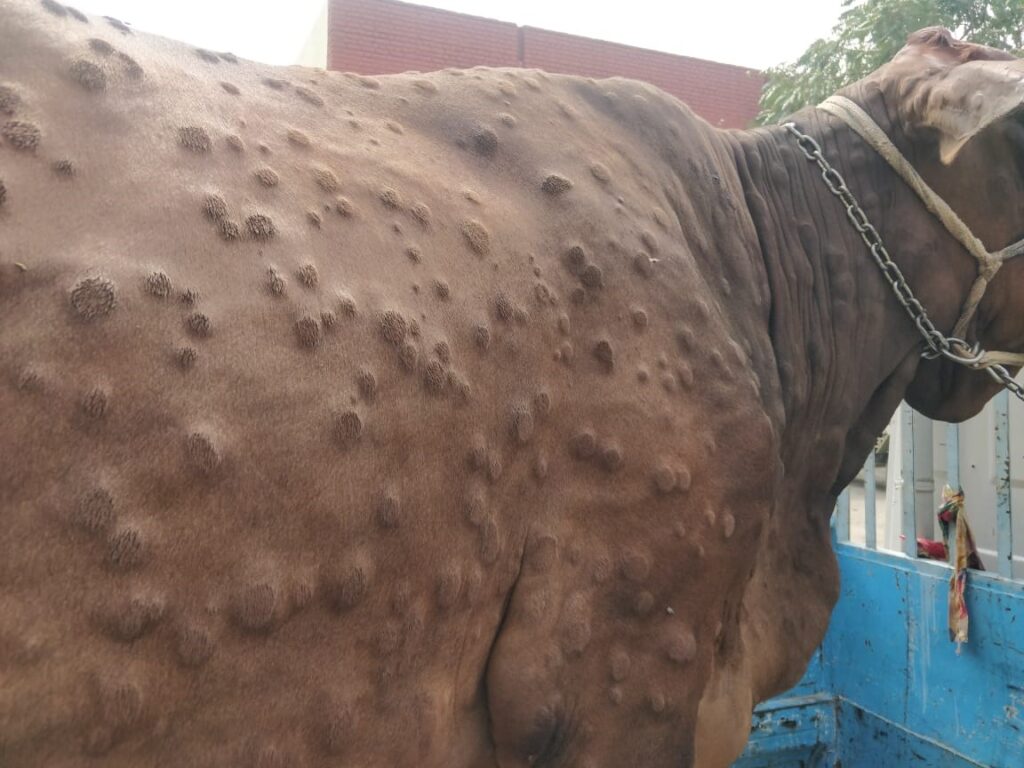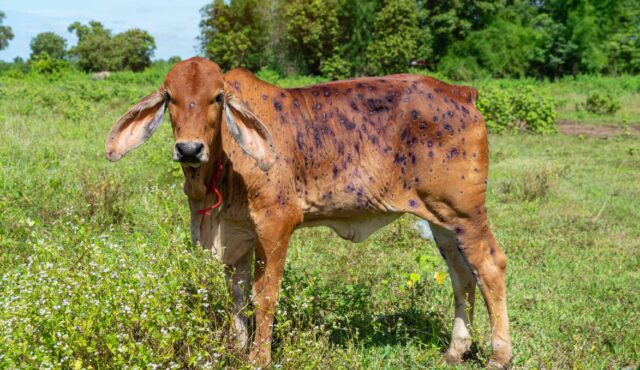The acute viral disease lumpy skin disease (LSD) in cattle is characterized by the abrupt emergence of many skin nodules of varied sizes and extents. Despite the disease’s low fatality rate, there are significant economic losses. Originally this disease was found in Africa but now it has also spread to countries in the Middle East, Asia, and Eastern Europe. Following its outbreak in Odisha in august 2019, and later on, LSD is now widespread in India, which had previously been free of it. The World Organization for Animal Health (OIE) announced this in November 2019.
- The most distinctive clinical sign is widespread, firm, painful nodules of the skin and mucosal surfaces.
- Attenuated virus vaccines may be used to help control the spread of infection
Etio-pathogenesis
Lumpy skin disease virus (LSDv), a DNA virus of the Poxviridae family and genus Capripox virus, is the culprit behind LSD. LSD has been linked to three main categories of cytopathic agents: Group I (Orphan strain), Group II (Allerton strain), and Group III (Neethling starin). The cause of LSD is now understood to be the Neethling strain. This genus also includes the viruses that cause goat and sheep pox. Both the sheep pox virus and the goat pox virus share genetic and antigenic similarities with the Neethling prototype strain.
After the pathogen enters the body, viremia with fever occurs, followed by localization in the skin, digestive system, and respiratory tract, as well as the development of inflammatory nodules. Young calves, breastfeeding cows, and malnourished people all get more severe sickness in a natural infection.
Epidemiology
LSD, formerly known as “pseudo urticaria,” was first identified as an epidemic in 1929 in Zambia (then Northern Rhodesia), and it has since spread over all of Africa. Eastern Europe and the Middle East have both seen its spread. Disease is most widespread along water courses and on low ground areas, and it can arise either epidemically or sporadically with high prevalence in the moist summer and fall months.
Economic Impact:
Millions of dairy farmers and meat sellers across the world are being hit hard by the LSD outbreak affecting their cattle. The small-scale cattle farmers who earn a living by selling off a few liters of milk have suffered enormously. Most of these farmers are illiterate and aren’t aware of prophylactic measures that are vital to stop the progression of LSD.
Host Susceptibility
Because LSDV only infects cattle (Bos indicus and Bos taurus) and water buffalo, it is very host-specific (Bubalus bubalis). Disease does not transmit to animals of different species. When it comes to cattle, the thin-skinned Bos taurus breeds are more prone than the thick-skinned native types. All breeds of cattle, regardless of sex or age, are prone. Young calves and dairy cows exhibit serious illnesses. Among the wild animals, the giraffe (Giraffa camelopardalis) is vulnerable. Mice, guinea pigs, and other laboratory animals are resistant to LSDv infection.
Mode of Transmission
There is still a good deal of information lacking about the transmission of LSD. Evidence to date supports transmission of the virus via arthropods such as insects or ticks (these are termed virus “vectors”). Ingestion of feed and water tainted with infected saliva, or fomites c.g., is another less likely method of virus transmission. Another option is to use unsterilized hypodermic needles repeatedly. Bulls with LSD infections can shed the virus in their semen, and this process can last for at least 42 days after the infection. Lesions or nodules on the skin are significant sources of infection. Despite the necrotic material being fully dried, LSDv has been observed to persist in skin lesions for at least 39 days after infection. Animals that are viremic are a key source of infection that may last for up to 2 weeks. Movement of infected cattle can also be a significant factor in the spread of LSD over large distances.
Clinical signs
- Incubation Period: 4 to 14 days.
- Initial Signs: Salivation, lacrymation, and mucopurulent nasal discharge,
- Other signs (may or may not): Swelling or edema of brisket, dewlap, and lower portions of the legs.
- Rectal temperature: above 41°C and/or biphasic.
- Typical Skin lesions: Nodules are well-circumscribed, round, slightly raised, firm, and painful and involve the entire cutis and the mucosa of the GI, respiratory, and genital tracts. Nodules form, ‘Sitfast’ skin exists. Nodules in every part of the body, including the lungs, perineum, vulva, mouth, and nasal passages. Nodules may later become necrosed, revealing the areas beneath.
- Other systems affected: Lymphadenopathy, milk production falls, mastitis, acute orchitis, atrophy of the scrotum/testes, preputial mucosa, and glans penis, bulls used for breeding produce less sperm, pneumonia due to extensive upper respiratory tract necrosis.
Diagnosis:
The presence of the typical skin nodules is strongly suggestive of LSD. F Disease can be confirmed with a laboratory diagnosis, with tests available to detect the DNA of the virus or antibodies. For molecular identification of viral antigen Samples of pus discharge, blood, semen, and scabs must be processed. Nodules, scabs, and crusts on the skin have higher levels of LSDV, making them a better option.
The most effective technique for detecting LSDv is polymerase chain reaction (PCR). ELISA, histopathology, cell culture, electron microscopy, and viral neutralization tests for the identification of antigen or antibody to LSDv are further diagnostic procedures.
Differential diagnosis
In moderate cases of LSD or during the initial outbreak, the clinical signs and lesions could be mistaken for pseudo lumpy skin disease, which is brought on by the Bovine Herpes Virus (BHV)-2. In comparison to LSD, BHV-2 has a shorter course, creates more superficial skin lesions, and is a milder condition. Theileriosis of the skin, photosensitization, dermatophytosis, and insect bites must occasionally be distinguished from pseudo-cowpox, foot-and-mouth disease, bovine viral diarrhoea, malignant catarrhal fever, infectious bovine rhinotracheitis, and cutaneous theileriosis.
Treatment: LSD’s therapeutic method is symptomatic.
- NSAIDs,
- Corticosteroids,
- Insect repellant,
- Antibiotics (ideally long acting),
- Antipyretics and other medications are used sparingly.
Immunization and vaccines
Any of the sheep pox, goat pox, and LSD virus strains can be utilized as a vaccine strain to protect cattle against LSD due to antigenic homology and cross-protection. LSD has been widely protected against by two vaccinations. However, all of these can cause local tissue responses in cattle.
The only practical method for limiting the spread of LSDV in an endemic area, though, is vaccination. After recovering from a natural infection, immunity lasts a lifetime. Calves from immunological cows develop maternal antibodies and develop clinical disease resistance for roughly six months.
Vaccination with attenuated virus offers the most promising method of control and was effective in halting the spread of the disease.
Prevention and Control
Using live attenuated vaccinations against the sheep and goat pox viruses as well as a comparable live attenuated vaccine against the LSD Neethling strain, countries like Israel, Ethiopia, and Lebanon have successfully suppressed LSD outbreaks. Other preventative strategies include limiting the movement of diseased cattle, controlling vectors, disposing of carcasses properly, managing breeding bulls, etc.
Summary
The long-term negative consequences of LSD are linked to significant economic losses in the form of decreased milk output, chrome corrosion, decreased hide quality, infertility, sterility, abortion, and death. Lumpy skin disease virus causes severe disease in cattle characterized by nodules in the skin. Transmission of LSD occurs via insect vectors and vaccination is the most effective means of control. Since the presence of a disease results in tight trade restrictions, the effects are also devastating on a national level. The main lesson to be learned from the current European LSD epidemic is to be vigilant of emerging diseases. Therefore, it is crucial for everyone to work together to regulate and contain this new issue with the cattle population.

Cow with LSD showing erupted, nodular, circumscribed lesions on the body
Authors:

Surbhi Gupta (PhD Scholar, Veterinary Medicine)
Gurpreet Singh Preet (Assistant Professor, Teaching Veterinary Clinical Complex)
Kuljeet Singh Dhaliwal (MVSc, Veterinary Medicine) Guru Angad Dev Veterinary and Animal Sciences University, Ludhiana- 141004















